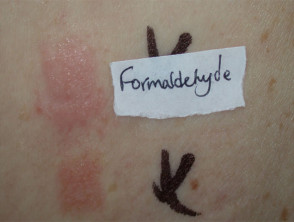What is formaldehyde and where is it found?
Formaldehyde is a chemical that is used widely across many products in our environment. It would be difficult to list all the possible sources of formaldehyde; the table below shows some of the more common sources of formaldehyde exposure.
| Sources of formaldehyde |
|
What are the reactions to formaldehyde?
Reactions to formaldehyde depend on the type of exposure that has occurred. Formaldehyde is not only a sensitiser but also a potent primary irritant. Exposure to formaldehyde gas may cause burning sensations in the eye, nose and throat, skin rashes, tightness of the chest and wheezing, fatigue and headaches. These symptoms may be a result of a primary irritant effect or an allergic sensitisation to formaldehyde.
Frequent or prolonged exposure may cause hypersensitivity, leading to the development of allergic contact dermatitis. Formaldehyde was declared the Contact Allergen of the Year for 2015 by the American Contact Dermatitis Society (ACDS).
Allergy to formaldehyde may occur through skin formaldehyde-containing products or with clothing made from fabrics containing formaldehyde. Dermatitis caused by clothing tends to affect parts of the body where there is the greatest friction between the skin and fabric, for example, "trouser dermatitis" is usually apparent on the inner thighs, gluteal folds and backs of the knees. Sweating may also be a factor in causing allergic dermatitis as sweat or sebum appears to leach free formaldehyde from formaldehyde resins. Individuals sensitive to formaldehyde are not necessarily hypersensitive to formaldehyde resins. Clothing dermatitis is reported to affect women more than men.
In highly sensitive individuals, contact with minute amounts of formaldehyde, or being in a room where a bottle of formaldehyde may have been open previously thus leaving residual gas, can cause dermatitis.
Am I allergic to formaldehyde?
Formaldehyde allergy is diagnosed from the clinical history and by performing patch tests.
Patch testing of formalin (40% solution of formaldehyde gas) is performed using a 2% aqueous solution of formalin. Some investigators have stated that 75% of positive patch tests have no clinical significance and only 20% of these can be related to actual instances of formaldehyde dermatitis.
The diagnosis of clothing dermatitis due to free formaldehyde can only be confirmed if the following standard criteria are fulfilled. In some cases, clothing dermatitis may not be a problem, even if the suspected fabric tests positive for free formaldehyde and an individual has a positive patch test reaction to 2% formalin.
| Formaldehyde clothing dermatitis — criteria to fulfil |
|
Patch testing of products for formaldehyde resins is performed using 10% urea formaldehyde in petrolatum, 10% melamine formaldehyde in petrolatum and 1% other formaldehyde resins in petrolatum or isopropyl alcohol.
Self-testing a product for formaldehyde should be done only with products that are designed to stay on on the skin such as cosmetics and lotions. Apply a small amount of the product to a small tender area of skin such as the bend of your arm or neck. Examine the area each day for several days, and if no reaction occurs, the product is most probably suitable for you to use.
Treatment of contact dermatitis due to formaldehyde exposure
If you are diagnosed with formaldehyde allergy then if at all possible avoid exposure to formaldehyde containing products, otherwise take means to reduce potential exposure.
Once dermatitis appears on the skin, treatment is as for any acute dermatitis/eczema, i.e. topical corticosteroids, emollients, treatment of any secondary bacterial infection (Staphylococcus aureus), etc.
What should I do to avoid formaldehyde allergy?
It is difficult to avoid all exposure to formaldehyde because it is normally present at low levels (usually <0.03 ppm) in both indoor and outdoor air. For most people, low-level exposure (up to 0.1 ppm) does not cause any problems. Methods to avoid or minimise exposure are described in the table below.
| Methods to avoid or minimise exposure to high levels of formaldehyde |
|
Alternative names for formaldehyde
Formaldehyde is also known by several other names. These include:
- Formalin
- Methanal
- Methyl aldehyde
- Methylene oxide
- Morbicid acid
- Oxymethylene.
Avoid all of these. At work, request a material safety data sheet to help identify potential sources of exposure.
Further information
Formula: CH20
CAS number: 50-00-0
Cross-reactions: possibly glutaraldehyde
Appearance: clear, colourless liquid
Sensitiser: free formaldehyde, formaldehyde resins
Patch Test:
2% aqueous solution of formalin (40% solution of formaldehyde gas)
10% urea formaldehyde in petrolatum
10% melamine formaldehyde in petrolatum
1% other formaldehyde resins in petrolatum or isopropyl alcohol.
| Sources of Exposure to Formaldehyde | ||
|---|---|---|
|
|
|
